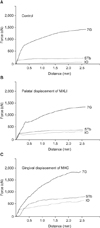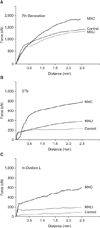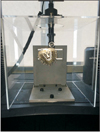Abstract
Objective
Methods
Results
Figures and Tables
Figure 1
The experimental set-ups used in this study.

Figure 4
A comparison of frictional forces among the 7th Generation (7G), STb, and In-Ovation L (IO) groups. A, The control group (no displacement); B, a 2-mm palatal displacement of the maxillary right lateral incisor (MXLI); and C, a 2-mm gingival displacement of the maxillary right canine (MXC).

Figure 5
A comparison of frictional forces among the control group (no displacement), a 2-mm palatal displacement in the maxillary right lateral incisor (MXLI) group, and a 2-mm gingival displacement in the maxillary right canine (MXC) group. A, 7th Generation (Ormco, Orange, CA, USA); B, STb (Ormco); and C, In-Ovation L (GAC, Dentsply Corp., York, PA, USA).

Figure 6
A comparison of original (solid lines) and effective slot dimensions (dotted lines) of brackets with a 2-mm gingival displacement of the maxillary right canine. From the left side, the 7th Generation (Ormco, Orange, CA, USA), STb (Ormco), and In-Ovation L brackets (GAC, Dentsply Corp., York, PA, USA) are shown.

Figure 7
Wire deflection from a 2-mm gingival displace ment of the maxillary right canine and 2-mm palatal displacement of the maxillary right lateral incisor.

Table 2
Static and kinetic frictional forces (cN) from a 2-mm palatal displacement of the maxillary right lateral incisor and 2-mm gingival displacement of the maxillary right canine

Values are presented as mean±standard deviation.
7th Generation (7G) and STb: Ormco, Orange, CA, USA; In-Ovation L (IO): GAC, Dentsply Corp., York, PA, USA.
*One-way analysis of variance (ANOVA); †Welch's variance-weighted ANOVA; ‡multiple comparison test was performed using Tukey's HSD; §multiple comparison test was performed using Dunnett's T3.
PD, Palatal displacement; MXLI, the maxillary right lateral incisor; GD, gingival displacement; MXC, the maxillary right canine.
Table 3
Comparisons of static and kinetic frictional forces according to displacement type

PD, Palatal displacement; MXLI, the maxillary right lateral incisor; Control, no displacement; GD, gingival displacement; MXC, the maxillary right canine.
*One-way analysis of variance (ANOVA); †Welch's variance-weighted ANOVA; ‡multiple comparison test was performed using Tukey's HSD; §multiple comparison test was performed using Dunnett's T3.




 PDF
PDF ePub
ePub Citation
Citation Print
Print





 XML Download
XML Download